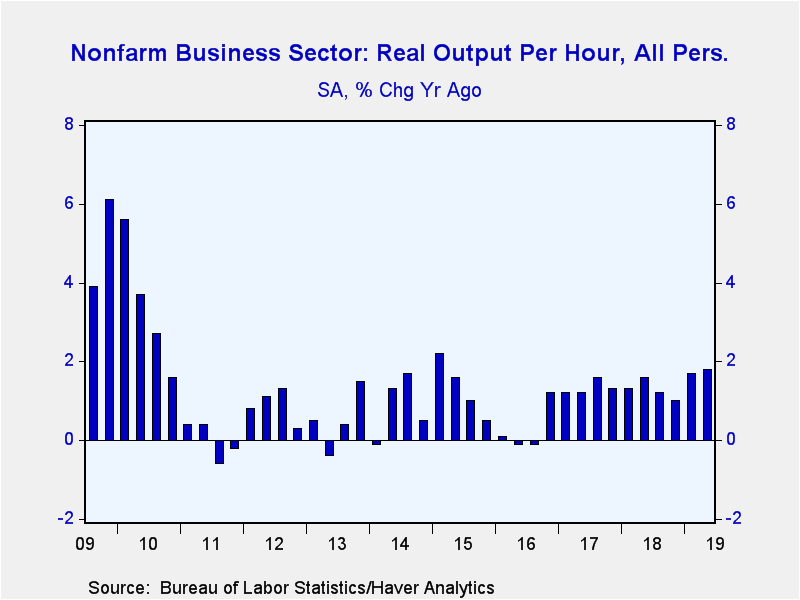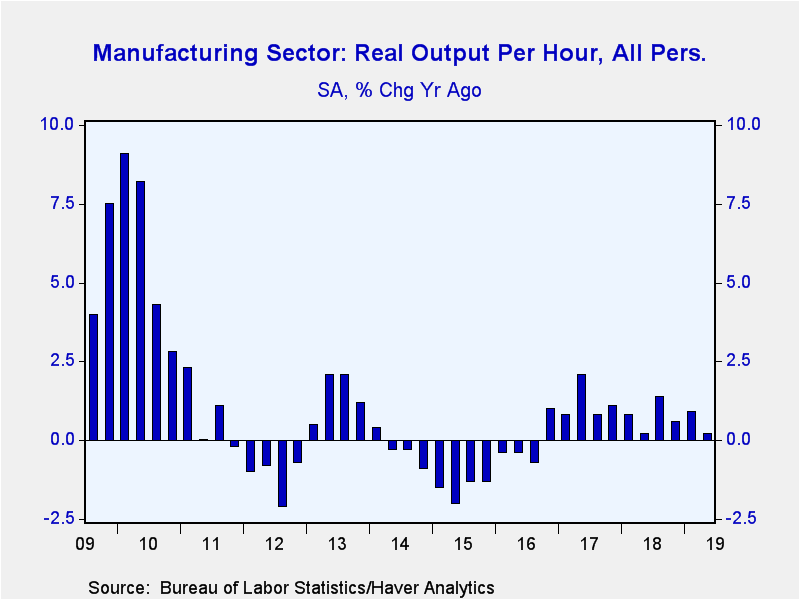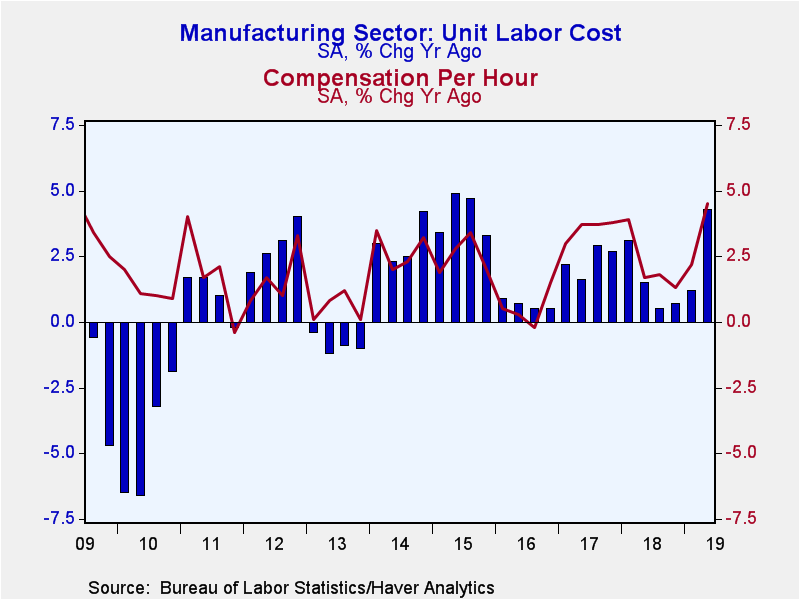 Global| Aug 15 2019
Global| Aug 15 2019U.S. Productivity Growth Increases in Q2, But Downward Revisions Shift Trend
Summary
Productivity in the nonfarm business sector grew at a greater-than-expected 2.3% seasonally adjusted annual rate during Q2'19 (1.8% year-on-year), following a slightly upwardly-revised 3.5% gain in Q1'19 (was 3.4%). The Action [...]
Productivity in the nonfarm business sector grew at a greater-than-expected 2.3% seasonally adjusted annual rate during Q2'19 (1.8% year-on-year), following a slightly upwardly-revised 3.5% gain in Q1'19 (was 3.4%). The Action Economics Forecast Survey expected a 1.6% increase in Q2. However, annual revisions took prior quarters' growth down meaningfully. Q4'18 productivity edged up just 0.1% versus the previously reported 1.3% gain. As a result, year-on-year growth in Q1'19 was taken down to 1.7% from 2.4% (which had been the quickest rate of increase since Q3'10). The gain in productivity in Q2 reflected a 1.9% rise (2.6% year-on-year) in real output coupled with a 0.4% decline (+0.8% y/y) in hours worked.
Despite healthy productivity growth in Q2, unit labor costs grew a faster-than expected 2.4% (2.5% y/y), as compensation costs jumped 4.8% (4.3% y/y). The Action Economics Forecast Survey expected a 1.9% gain in Q2. Compensation was revised substantially higher to a 9.2% rate Q1 -- the fastest rate since the end of 2012 -- raising unit labor cost growth to 5.5% (was -1.6%) and 1.5% y/y (was -0.8%). As a result of the revisions to productivity and compensation, the downward trend in unit labor costs that was evident before the revisions has been reversed.
In the manufacturing sector, productivity fell 1.6% last quarter (+0.2% y/y) following an upwardly-revised 1.1% rise during Q1'19, (was 0.4%). Revisions to previous quarters' productivity were less substantial, thus y/y growth in Q1 was revised up just 0.1 percentage point. The decrease in productivity in Q2 reflected a 2.1% drop (+0.4% y/y) in real output accompanied by a 0.5% decline (+0.2% y/y) in hours worked.
Unit labor costs in the factory sector jumped 5.8% (4.3% y/y -- the fastest growth since Q3'15) following an upwardly revised 6.8% gain Q1 rise (was 2.0%). Compensation increased 4.1% (4.5% y/y) in Q2 following a 8.0% surge during Q1'19. The revisions to compensation raised unit labor cost growth to 1.2% y/y in Q1 from the previously report flat reading.
The productivity & cost figures are available in Haver's USECON database. The expectations figures are from the Action Economics Forecast Survey and are found in the AS1REPNA database.
| Productivity & Costs (SAAR, %) | Q2'19 | Q1'19 | Q4'18 | Q2'19 Y/Y | 2018 | 2017 | 2016 |
|---|---|---|---|---|---|---|---|
| Nonfarm Business Sector | |||||||
| Output per Hour (Productivity) | 2.3 | 3.5 | 0.1 | 1.8 | 1.3 | 1.3 | 0.3 |
| Compensation per Hour | 4.8 | 9.2 | 0.7 | 4.3 | 3.1 | 3.5 | 1.1 |
| Unit Labor Costs | 2.4 | 5.5 | 0.6 | 2.5 | 1.8 | 2.1 | 0.8 |
| Manufacturing Sector | |||||||
| Output per Hour (Productivity) | -1.6 | 1.1 | 0.9 | 0.2 | 0.7 | 1.2 | -0.1 |
| Compensation per Hour | 4.1 | 8.0 | 3.4 | 4.5 | 2.2 | 3.5 | 0.5 |
| Unit Labor Costs | 5.8 | 6.8 | 2.5 | 4.3 | 1.4 | 2.3 | 0.6 |
Gerald D. Cohen
AuthorMore in Author Profile »Gerald Cohen provides strategic vision and leadership of the translational economic research and policy initiatives at the Kenan Institute of Private Enterprise.
He has worked in both the public and private sectors focusing on the intersection between financial markets and economic fundamentals. He was a Senior Economist at Haver Analytics from January 2019 to February 2021. During the Obama Administration Gerald was Deputy Assistant Secretary for Macroeconomic Analysis at the U.S. Department of Treasury where he helped formulate and evaluate the impact of policy proposals on the U.S. economy. Prior to Treasury, he co-managed a global macro fund at Ziff Brothers Investments.
Gerald holds a bachelor’s of science from the Massachusetts Institute of Technology and a Ph.D. in Economics from Harvard University and is a contributing author to 30-Second Money as well as a co-author of Political Cycles and the Macroeconomy.









